Abstract 1. Physical and chemical characteristics of nickel Metal nickel, chemical symbol Ni, atomic number 28, density 8.902 g/cm 3 , melting point 1453 ° C, boiling point 2732 ° C. Nickel is a silver-white metal that has good strength and ductility at low temperatures, at room temperature...
First, the physical and chemical characteristics of nickel Metal nickel, chemical symbol Ni, atomic number 28, density 8.902 g/cm 3 , melting point 1453 ° C, boiling point 2732 ° C. Nickel is a silver-white metal. It has good strength and ductility at low temperatures. At room temperature, a dense oxide film forms on the surface in humid air, which prevents the oxidation from continuing. Nickel is also easily alloyed with other metals.
Second, the main use of nickel
Nickel is an important industrial metal widely used in the steel industry, machinery industry, construction industry and chemical industry. Specific uses include: first, as a metal material, including the production of stainless steel, heat-resistant alloy steel and various alloys; second, for electroplating, covering a substrate of steel and other metal materials with a durable, corrosion-resistant The surface layer has higher corrosion resistance than the galvanized layer; thirdly, it is used as a catalyst in the hydrogenation process of petrochemicals; fourth, it is used as a chemical power source to prepare raw materials for nickel-hydrogen batteries and nickel-cadmium batteries; And dyes, making new materials such as ceramics and ferrite.
Third, the main classification of nickel
Nickel can be divided into primary nickel and regenerated nickel according to the different raw materials. The raw material for the production of raw nickel comes from nickel ore, and the raw material for the production of recycled nickel comes from nickel-containing waste. Primary nickel includes electrolytic nickel, nickel iron, and nickel salts. Among them, according to the national standard GB/T6516-2010, electrolytic nickel can be divided into five grades: Ni9999, Ni9996, Ni9990, Ni9950, Ni9920; nickel iron, also known as nickel-containing pig iron, is an alloy of nickel and iron, mainly composed of laterite nickel. The ore is smelted and sintered by fire method. The nickel metal content of ferronickel is about 5%~30%. According to the nickel content, it can be divided into high nickel pig iron, medium nickel pig iron and low nickel pig iron.
International nickel market
I. Nickel market supply situation
(1) Production of nickel ore
The mineral resources of nickel are mainly divided into nickel sulfide ore and nickel oxide ore (also known as " laterite nickel ore"). In recent years, with the gradual decline of global nickel sulfide ore reserves, the proportion of laterite nickel ore has reached 70%. The global nickel ore production (the amount of nickel metal) has gradually increased from 1.31 million tons in 2004 to 2.53 million tons in 2013. Among them, Indonesia and the Philippines, which are rich in laterite nickel ore, rank among the top two in the world. In 2013, the output was 850,000 tons and 310,000 tons respectively.
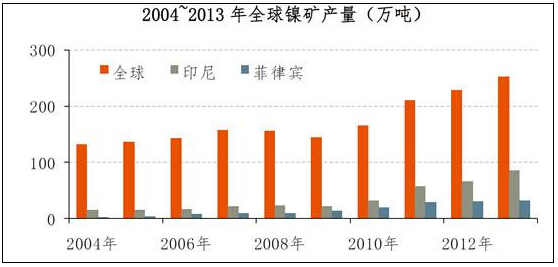
(2) Production of primary nickel
Global global nickel production (the amount of nickel metal) has gradually increased from 1.26 million tons in 2004 to 1.98 million tons in 2013. Among them, China is the world's largest producer of primary nickel, with raw nickel production in Russia, Japan, Canada and Australia ranking second to fifth respectively.
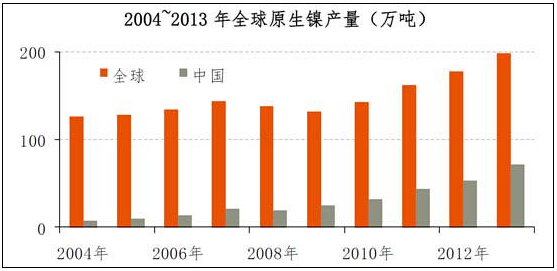
Second, the nickel market demand situation
Global global nickel consumption increased from 1.27 million tons in 2004 to 1.83 million tons in 2013. Among them, China is the world's largest consumer of primary nickel. In 2013, consumption accounted for more than 50% of the world's total. The United States, Japan, South Korea and Germany accounted for the second to fifth largest raw nickel consumption in the world.

Third, the trade of nickel
According to the statistics of GTIS (Global Trade Information Service), the global export of refined nickel in 2013 was about 800,000 tons. Russia, Canada, the Netherlands, Norway and Singapore are the major exporters; the global report on refined nickel imports is about 87 tons. Ten thousand tons, China, the Netherlands, the United States, Malaysia, Germany, and Singapore are major importers. Among them, the Netherlands, Malaysia and Singapore are not the major producers and consumers of refined nickel. Due to the establishment of delivery warehouses in these three countries, LME has made the Netherlands, Malaysia and Singapore an important global distribution center for refined nickel logistics.
Domestic nickel market
I. Nickel market supply situation
(1) China's nickel production
1. Production of nickel ore
China's nickel ore resources are limited, and nickel ore resources are highly dependent on foreign countries. In 2013, China's nickel ore production (the amount of nickel and metal) was about 92,000 tons, of which Gansu Province accounted for about 80%, and Gansu, Jilin and Xinjiang accounted for more than 90%.

China's primary nickel production (the amount of nickel metal) increased from 76,000 tons in 2004 to 710,000 tons in 2013, and the world share increased from 6% to 36%. Among them, the output of electrolytic nickel increased from 76,000 tons in 2004 to 278,000 tons in 2013, and the output of ferronickel (nickel-nickel metal) was only 0.3 million tons in 2005 and more than 400,000 tons in 2013.
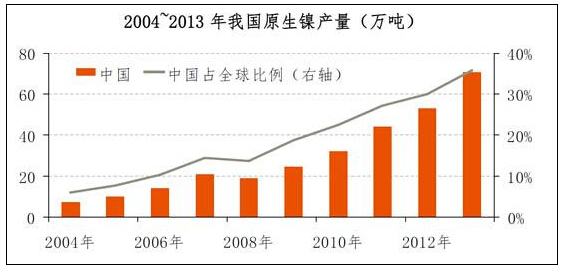
(II) Distribution of electrolytic nickel production in various regions
In terms of provinces and cities, Gansu is the province with the largest output of electrolytic nickel in China. In 2013, the output was 144,000 tons, accounting for 52% of the national total. Shaanxi and Jiangxi ranked second and third, accounting for 15% respectively. 13%; other provinces and cities have relatively small production.
In 2013, the proportion of China's electrolytic nickel production by province and city
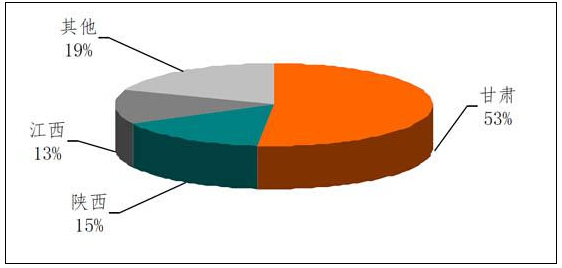
(1) Distribution of nickel consumption in various regions
China's primary nickel consumption increased from 150,000 tons in 2004 to 950,000 tons in 2013, and its share of total world consumption increased from 12% in 2003 to 52% in 2013. It is the world's largest consumer of primary nickel. From the perspective of consumption areas, East China is China's largest nickel consumption area, accounting for up to 50%. North China and South China are also important consumption areas, accounting for 20% and 18% respectively.
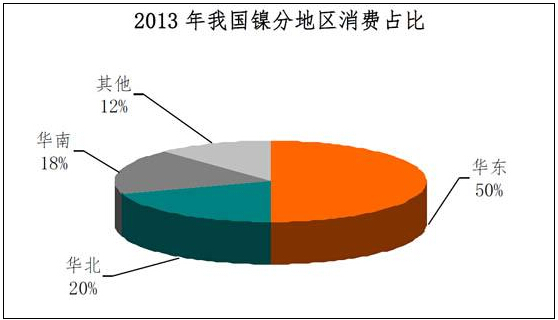
Nickel is widely used in the steel industry, machinery industry, construction industry and chemical industry.
1. Steel industry
Stainless steel is the most important downstream consumer of nickel. The addition of nickel to stainless steel forms austenite and improves the high temperature strength of stainless steel. Austenitic stainless steel generally contains about 8% nickel, which has good plasticity, toughness, weldability and corrosion resistance.
2, electroplating industry
Electroplating and electroless plating are also one of the major consumer areas of nickel. The steel and other metal substrates are covered with a durable, corrosion-resistant surface layer that is 20% to 25% more corrosion resistant than galvanized layers.
3, battery material
Compared with common lead-acid batteries, the life of nickel-metal hydride batteries can be increased by 3 to 4 times. Nickel-cadmium and nickel-hydrogen rechargeable battery cathode materials widely used in the world are widely used in nickel powder, and the demand for nickel is large.
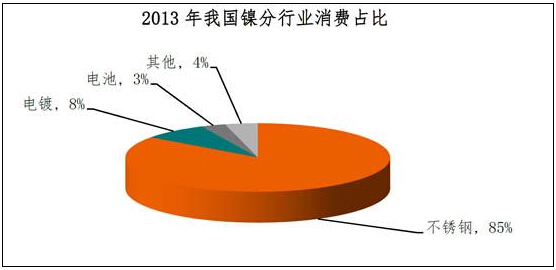
Third, the import and export of nickel
China is a country with a shortage of nickel resources, and nickel's external dependence exceeds 80%. In order to meet the strong demand of the domestic stainless steel industry, a large amount of nickel resources need to be imported from abroad every year. Imported nickel resources mainly include three forms: nickel ore, nickel intermediates and electrolytic nickel.
(1) Import of nickel ore
With the rapid development of the domestic ferronickel industry, China's demand for imported nickel ore has increased rapidly, from 480,000 tons in 2005 to 71.18 million tons in 2013. Indonesia and the Philippines are the two largest sources. In 2014, due to Indonesia's export ban on nickel ore, the Philippines has replaced Indonesia as the largest supplier of nickel ore in China.
(ii) Import of nickel intermediate products
Nickel intermediate products include sintered nickel oxide, nickel ruthenium, wet smelting intermediates and ferronickel. The imports of sintered nickel oxide and nickel iron are mainly used by domestic stainless steel enterprises. The imports of nickel bismuth and wet smelting intermediate products are mainly for domestic nickel smelting enterprises to produce electrolytic nickel.
(3) Import and export of electrolytic nickel
In recent years, China's imports of electrolytic nickel have remained at a relatively high level. The main source countries of China's imports are Russia, Canada, Norway, Japan and Australia. However, since 2012, due to the sharp increase in domestic ferronickel production, the demand for electrolytic nickel in the stainless steel industry, which is the main consumer of nickel, has gradually slowed down. The main destinations for China's electrolytic nickel exports are South Korea, Singapore, and the Netherlands. The way is that China's bonded area nickel stocks flow into LME's local delivery warehouse.

Nickel price influencing factors
First, the nickel market price fluctuates sharply
In recent years, nickel prices have fluctuated drastically. LME's March nickel closing price has continued to rise from $7,130/ton in early 2003 to a record high of $5,1600/ton in May 2007, with a cumulative increase of 620%. However, affected by the international financial crisis of 2008-2009, LME nickel prices fell to $9050/ton on December 5, 2008. In January 2014, since the implementation of the policy prohibiting the export of laterite nickel ore in Indonesia, the LME nickel price has once again gained momentum. In just 5 months, it broke through $20,000/ton from the beginning of the year at $13,500/ton, with a cumulative increase of about 50. %. Affected by the violent fluctuations in international nickel prices, the domestic nickel spot market price fluctuations are also very intense.
LME March nickel closing price (USD/ton) from 2003 to 2014
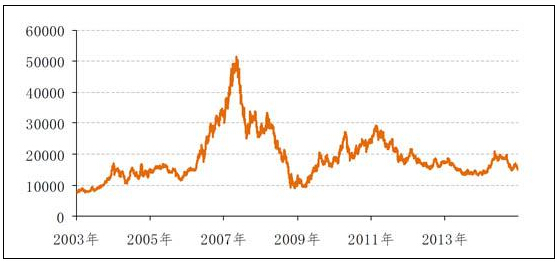
Second, the main factors affecting the price of nickel
(1) Supply and demand relationship
The relationship between supply and demand is the most important factor in determining long-term price trends. From 2011 to 2013, due to the rapid expansion of China's nickel-iron production capacity, the global nickel market showed a serious excess, resulting in the international nickel price continued to fall sharply. However, in January 2014, with the announcement of the implementation of the raw ore export ban policy by Indonesia, the world's largest nickel exporter, the market has raised widespread concerns about the supply gap in nickel. The international nickel price reversed the previous weakness.
(2) High and low points of upstream and downstream cost-constrained prices
The supply and demand relationship determines the price trend, and the cost determines the upper and lower limits of the price. The cost of the downstream industry determines the upper limit of nickel price. When the downstream industry cost can no longer bear the increase of nickel price and the loss occurs, the market price tends to change from rising to falling. The average production cost of the nickel smelting industry determines the lower limit of nickel price. When smelting companies generally suffer losses, the space for nickel prices to continue to fall may not be large.
(3) Import and export policy
Indonesia and the Philippines are the world's two largest nickel producers and exporters, accounting for about 40% of global nickel production in 2013. Therefore, the import and export policies of the two countries on nickel ore have a crucial impact on the trend of nickel prices.
As early as 2009, the Indonesian government had indicated that it plans to implement the nickel mine export ban from 2014. However, in response to questions about the efficiency of the Indonesian government, the market generally underestimated the influence of the policy. When Indonesia implemented the export ban on schedule in January 2014, it triggered a crazy rise in nickel prices. In September 2014, the rumors that the Philippines may follow Indonesia’s ban on raw ore exports once again stimulated a sharp rise in nickel prices.
(4) Market expectations play a role in boosting price fluctuations
Changes in market expectations have helped push prices up and down by changing supply and demand and market capitalization. If the market is expected to rise in future price trends, traders and downstream companies tend to be more aggressive in ordering and increasing inventories, stimulating further increases in market prices; and vice versa.
Homogeneous Flooring,Homogeneous Vinyl Flooring,Homogeneous Pvc Flooring,Firproot Pvc Flooring Sheet
JIANGSU HUAJING FLOOR TECHNOLOGY CO.,LTD , https://www.huajing-floor.com